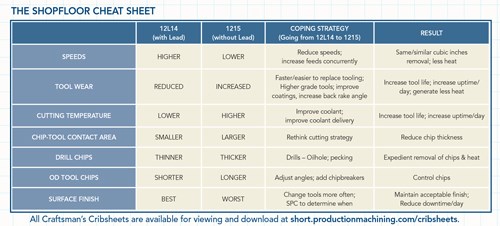Craftsman's Cribsheet: Unleaded Brass, Change Your Thinking
Unleaded brasses are not necessarily harder to run than leaded brass.
Unleaded brasses are not necessarily harder to run than leaded brass. They are just different. By recognizing and accommodating for their lack of lead, and the resultant different thermal conductivity, differences in chip forming and the need to up-tool for heavier feeds rather than higher speeds, your shop can be successful at making parts from these newer, more challenging grades.
What are some strategies for machining the unleaded brasses?
- Increase the feed. Since we lost the lead and the ability to run at higher speeds, increasing the feed can help us get to equivalent cubic inches of removal rates.
- Improve the machine rigidity. Heavier feeds mean the machine needs to be adjusted and solid. It also means more horsepower required, again mandating a rock-solid setup.
- Improve the tool. Even 4 percent lead is very forgiving of tool quality; the nonleaded grades are the opposite—they present a number of challenges to your tools. Improved materials, geometry and coatings are key to machining unleaded brasses with minimum issues. They will require fewer replacements, helping to get more net production at the end of the shift.
- Improve the chip management. Some unleaded grades replace the lead with zinc, resulting in a grade with a type III chip, stringy and birds-nest prone. With these grades, pay attention to drills selected, and try inserts with chip control features to help you manage that chip.
- Deal with the increased heat. The lead helped to reduce friction and heat in the leaded grades. With the lead removed, you will have increased heat generated. Carbide is more forgiving of heat, as are tool coatings. Talk to your supplier of metalworking fluids. Chances are they will have a fluid that will help manage those extra BTUs and maintain your tools’ edges.
- Change your ideas about machining brass. Unleaded brass machines more like steel than brass. As long as you think of it like leaded brass, you will fight it. Instead, think of it as just a yellow version of 1215 steel or stainless and your expectations will be much closer to reality.
The market for precision machined parts continues to evolve. Evolve your thinking and processing to adjust to the realities of unleaded materials to remain a viable and preferred supplier.

— Precision Machined Products Association


